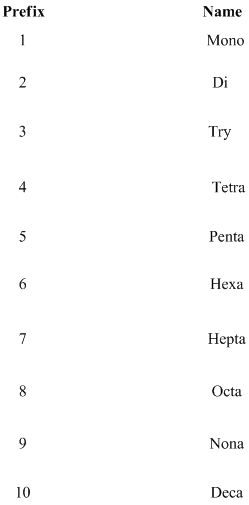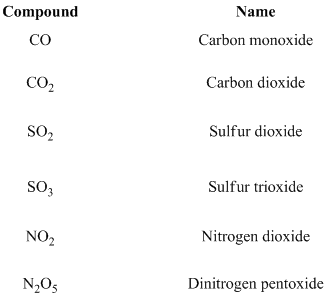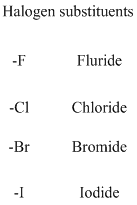
Interpretation:
The chemical formula for the given molecule should be identified.
Concept introduction:
According to the nomenclature, when two nonmetals are present in the given compound the name of the compound is given as follows, For example, HCl. According to the name of the compound, first give the name for the hydrogen followed by the second element, changing the ending of its name to –ide. Chlorine called as chloride. Therefore HCl is hydrogen chloride. Similarly, HI is hydrogen iodide. SiC is silicon carbide.
One pair of elements to form several different binary molecular compounds. In these cases, using of Greek prefixes to denote the number of atoms of each element present.
Greek prefixes are given below,

If prefix mono substituted is generally omitted for the first element. For example, SO2 is named sulfur dioxide, is not monosulfur dioxide. Moreover, only one atom in a prefix for the first element, no needs to mention mono or di etc.… In addition, for ease of pronunciation, we usually eliminate the last letter of a prefix that ends in o or a when naming an oxide. Thus, N2O5 is dinitrogen pentoxide, rather than dinitrogen pentaoxide.

If any halogens are present in the molecule in suffix, the name of the halogens as follows.

Want to see the full answer?
Check out a sample textbook solution
Chapter 5 Solutions
EBK CHEMISTRY: ATOMS FIRST
- Provide the reagents for the following reactions.arrow_forwardIf I have 1-bromopropene, to obtain compound Z, I have to add two compounds A1 and A2. Indicate which compounds are needed. P(C6H5)3arrow_forwardDraw the major product of this reaction. Ignore inorganic byproducts. Assume that the water side product is continuously removed to drive the reaction toward products. O CH3CH2NH2, TSOH Select to Draw >arrow_forward
- Indicate the products obtained by reacting fluorobenzene with a sulfonitric mixture.arrow_forwardIf I have 1-bromopropene, to obtain compound A, I have to add NaOH and another compound. Indicate which compound that would be. C6H5 CH3arrow_forwardIf I have 1-bromopropene and I want to obtain (1,1-dipropoxyethyl)benzene, indicate the compound that I should add in addition to NaOH.arrow_forward
- Draw the major product of this reaction. Ignore inorganic byproducts. Ο HSCH2CH2CH2SH, BF3 Select to Draw I Submitarrow_forwardFeedback (7/10) Draw the major product of this reaction. Ignore inorganic byproducts. Assume that the water side product is continuously removed to drive the reaction toward products. Incorrect, 3 attempts remaining Ο (CH3CH2)2NH, TSOH Select to Draw V N. 87% Retryarrow_forwardIf I want to obtain (1,1-dipropoxyethyl)benzene from 1-bromopropene, indicate the product that I have to add in addition to NaOH.arrow_forward
 Introductory Chemistry: An Active Learning Approa...ChemistryISBN:9781305079250Author:Mark S. Cracolice, Ed PetersPublisher:Cengage Learning
Introductory Chemistry: An Active Learning Approa...ChemistryISBN:9781305079250Author:Mark S. Cracolice, Ed PetersPublisher:Cengage Learning Chemistry: The Molecular ScienceChemistryISBN:9781285199047Author:John W. Moore, Conrad L. StanitskiPublisher:Cengage Learning
Chemistry: The Molecular ScienceChemistryISBN:9781285199047Author:John W. Moore, Conrad L. StanitskiPublisher:Cengage Learning

